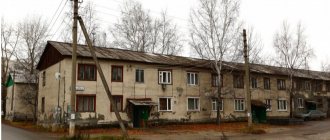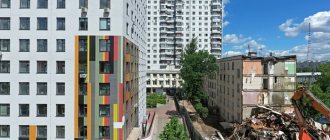Home / Housing disputes / Privatization of emergency housing
Emergency and dilapidated housing is unsuitable for living. However, to this day such houses are occupied by entire families who have nowhere else to live. Naturally, they cling to any opportunity and often want to privatize housing.
The state program allows a limited number of objects available for privatization. Art. 4 Federal Law No. 1541-1 “On Privatization...” directly prohibits the privatization of emergency housing. But is everything so clear? In fact, no - if a house is recognized as dilapidated, then the apartments in it can be privatized. True, with reservations and not in all cases.
After reading our article, you will learn: what is commonly understood as emergency housing, how it differs from dilapidated housing, and how to privatize such types of housing forcibly?
✅ What is emergency housing?
Russian legislation defines the concept of “emergency housing” as unsuitable for habitation. Often these are apartments that pose a threat to the life and health of residents. Most worn-out residential properties are subject to major repairs. The rest are subject to immediate demolition. Residents of a damaged house receive compensation or are relocated to other houses.
Signs of emergency housing:
- Worn-out load-bearing structures, the threat of their collapse.
- The house is located in an unsuitable place for living (wetlands, threat of landslides, landslides).
- Internal and external damage to important communications.
- The location of the house in the area of the supposed man-made disaster.
The emergency condition of an apartment building can be identified using a special examination . Monitoring is carried out by local authorities. However, in some cases, the residents of the building may report a fault. For example, if problems are not visible from the outside, but create discomfort inside the apartment.
Required documents
To achieve the convening of an interdepartmental commission, the applicant must provide:
- an application demanding that the house be recognized as unsafe;
- photocopy of documents confirming ownership;
- a project for converting non-residential premises into residential ones, if any;
- a report from a special organization involved in the inspection of housing in order to identify wear and tear and other parts that interfere with living in the house;
- conclusion of the design and survey organization on the result of the examination of load-bearing and other structures (sometimes there is no need for such a conclusion);
- letters and complaints from citizens dissatisfied with the condition of their own housing.
Additionally, they may require technical documentation (technical passport and floor plan), as well as papers confirming ownership of the house.
✅ Is it possible to privatize emergency housing, an apartment in an emergency building?
The law directly prohibits the privatization of emergency housing, no matter what condition it is in. Consequently, if the authorities recognize the house as unsafe, municipal apartments cannot be transferred to the ownership of private individuals. But what if the building is not unsafe, but dilapidated?
Let’s immediately make a reservation that “emergency” and “dilapidated” housing are not the same concept, but different states of an apartment building.
Emergency housing - an object recognized as unsuitable for habitation due to damage to the load-bearing structures by more than 70%; is not subject to major repairs, but is demolished immediately or over time (see “Demolition of privatized housing”). Dilapidated housing is an object whose deterioration is 65-70%, and the house itself does not pose a danger to human habitation (MKD 2-04.2004). Although the law does not directly say anything about this, you can privatize such objects - at your own peril and risk. Of course, with the obligation to independently repair the apartment.
On a note! There is no definition of the concept of “dilapidated housing” in the legislation. The privatization of such objects developed on the basis of life situations.
The emergency status of a house is determined after a state examination. All issues are handled by interdepartmental commissions - the Committee of State Construction Supervision, the Main Directorate of the Ministry of Emergency Situations of Russia and others. Having discovered serious violations, the authorities draw up a conclusion, which is submitted to Rosreestr for amendments. If there is no such conclusion, the house can be considered “dilapidated”. Consequently, privatization will become possible.
Example:
Residents of the council house lived in “Spartan” conditions. The building was put into operation in Soviet times, but over time it fell into disrepair. Municipal authorities monitored changes to the house's design. After one of these inspections, it was decided to recognize the building as unsafe. They wanted to resettle the residents, but they did their best to prevent this - the desire to privatize the apartments remained. The initiative group appealed to the court with a request to allow privatization. However, they were refused. The court cited Art. 4 Federal Law No. 1541-1 “On Privatization...”, which states that emergency housing cannot be transferred to private ownership due to its unsuitability for habitation. The residents had to give in and be content with moving to a new house.
Housing Code
Housing properties can be privatized only in the manner prescribed by the Housing Code (LC) of the Russian Federation.
In relation to emergency housing, Art. 4 of Law No. 1541-1. It has been in force since 07/04/1991 and states that the privatization of such premises is prohibited (except for cases when the emergency status is removed from them).
There are also several types of objects to which this law does not apply:
- state farms;
- agricultural enterprises;
- social institutions.
Additional points regarding emergency housing are discussed in Art. 32 Housing Code of the Russian Federation.
✅ Pros and cons
Is it worth privatizing an obviously unsafe and dilapidated facility? The answer to this question depends on the wishes of the residents. Some people want to become the owner of an apartment and then improve their living conditions. For some, it is more profitable to wait for resettlement in other houses (see “Program for relocation from dilapidated and dilapidated housing”).
Let's consider the pros and cons of privatization of dilapidated housing:
| Advantages | Flaws |
| Receiving compensation - in the event of demolition of the house, the owners of privatized apartments will receive compensation from the authorities. Even if dilapidated housing is inexpensive, it is better than getting nothing at all. | Using an attempt at free privatization of housing - having become the owner of an apartment in a dilapidated building, a person will no longer be able to take advantage of free privatization. Therefore, many are waiting to move into new houses, and only then proceed to privatization. |
| Resettlement is the second option that can be used by residents of privatized housing for demolition. At the same time, they are entitled to at least 18 square meters. meters per person. Resettlement takes place in apartments on the secondary housing market. | Tax, contributions for major repairs, maintenance of the property of an apartment building - financial expenses are borne by the owners. Moreover, non-payment of taxes threatens with administrative and even criminal liability. |
| Registration/extract from an apartment – the owner of the apartment has the right to free registration. If you can move family members into municipal housing, then there are no restrictions with a privatized apartment. | Installation of indoor water meters - all this will also place a financial burden on the shoulders of the apartment owner. |
About resettlement
When demolishing dilapidated and emergency housing, resettlement always occurs . Upon relocation, they receive equal housing.
In 2011, some amendments were made to the housing provision law. Based on these changes, home owners and tenants of living space have become equal in rights.
Before this, residents under a social lease agreement could count on a living space of 18 square meters. m. per registered person. However, at the moment they can only expect to receive an equivalent area. Owners of privatized housing are also entitled to the same share.
Thus, privatization of housing does not provide any additional privileges. Just as registration of a large number of citizens in one area does not give the right to expand new living space. The only difference between a privatized apartment during demolition is that the tenant can be paid compensation equal to the market value.
When demolition of emergency housing, the owners of municipal apartments are evicted , and the social rental agreement is terminated. In return, citizens receive another comfortable living space with the conclusion of a new social rental agreement (Article 86 of the Housing Code of the Russian Federation).
Article 86 of the RF Housing Code. The procedure for providing residential premises under a social tenancy agreement in connection with the demolition of a house
If the house in which the residential premises occupied under a social tenancy agreement is located is subject to demolition, the citizens evicted from it by the state authority or local government body that made the decision to demolish such a house are provided with other comfortable residential premises under social tenancy agreements.
Local government officials deal with questions about the size of the new living space provided. At the moment, this issue has not been resolved at the legislative level.
Therefore, everything depends on the specific case. In one situation, citizens who were on the waiting list for improvement can be provided with housing in accordance with the standards. In another situation, equivalent living space may be provided. Sometimes families can even get several separate apartments. It all depends on the region of residence and the policies of local governments.
✅ How to privatize an apartment in dilapidated housing?
So, if the housing is not recognized as unsafe, it can be privatized. But first you need to set the status to “dilapidated”. Or rather, confirm that the house is not in disrepair and is suitable for human habitation.









